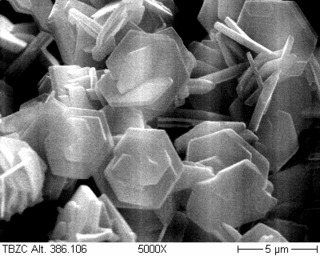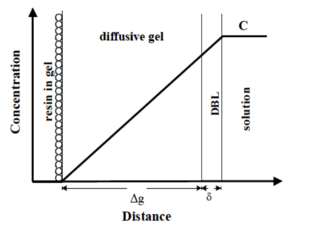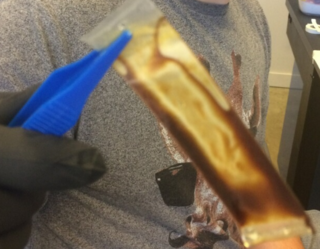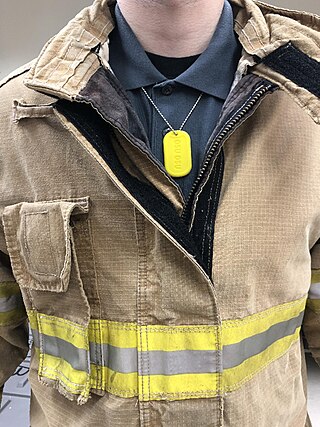Chelation is a type of bonding of ions and their molecules to metal ions. It involves the formation or presence of two or more separate coordinate bonds between a polydentate ligand and a single central metal atom. These ligands are called chelants, chelators, chelating agents, or sequestering agents. They are usually organic compounds, but this is not a necessity.

Pentetic acid or diethylenetriaminepentaacetic acid (DTPA) is an aminopolycarboxylic acid consisting of a diethylenetriamine backbone with five carboxymethyl groups. The molecule can be viewed as an expanded version of EDTA and is used similarly. It is a white solid with limited solubility in water.

Naphthenic acids (NAs) are mixtures of several cyclopentyl and cyclohexyl carboxylic acids with molecular weights of 120 to well over 700 atomic mass units. The main fractions are carboxylic acids with a carbon backbone of 9 to 20 carbons. McKee et al. claim that "naphthenic acids (NAs) are primarily cycloaliphatic carboxylic acids with 10 to 16 carbons", although acids containing up to 50 carbons have been identified in heavy petroleum.

Environmental toxicology is a multidisciplinary field of science concerned with the study of the harmful effects of various chemical, biological and physical agents on living organisms. Ecotoxicology is a subdiscipline of environmental toxicology concerned with studying the harmful effects of toxicants at the population and ecosystem levels.

Chelates in animal feed is jargon for metalloorganic compounds added to animal feed. The compounds provide sources of various metals that improve the health or marketability of the animal. Typical metals salts are derived from cobalt, copper, iron, manganese, and zinc. The objective of supplementation with trace minerals is to avoid a variety of deficiency diseases. Trace minerals carry out key functions in relation to many metabolic processes, most notably as cofactors for enzymes and hormones, and are essential for optimum health, growth and productivity. For example, supplementary minerals help ensure good growth, bone development, feathering in birds, hoof, skin and hair quality in mammals, enzyme structure and functions, and appetite. Deficiency of trace minerals affect many metabolic processes and so may be manifested by different symptoms, such as poor growth and appetite, reproductive failures, impaired immune responses, and general ill-thrift. From the 1950s to the 1990s most trace mineral supplementation of animal diets was in the form of inorganic minerals, and these largely eradicated associated deficiency diseases in farm animals. The role in fertility and reproductive diseases of dairy cattle highlights that organic forms of Zn are retained better than inorganic sources and so may provide greater benefit in disease prevention, notably mastitis and lameness.

Zinc chloride hydroxide monohydrate or more accurately pentazinc dichloride octahydroxide monohydrate is a zinc hydroxy compound with chemical formula Zn5(OH)8Cl2·H2O. It is often referred to as tetrabasic zinc chloride (TBZC), basic zinc chloride, zinc hydroxychloride, or zinc oxychloride. It is a colorless crystalline solid insoluble in water. Its naturally occurring form, simonkolleite, has been shown to be a desirable nutritional supplement for animals.
Chemcatcher is a passive sampling device for monitoring a variety of pollutants in water. It is a reusable three component, water-tight PTFE body. Two different designs are available to accommodate different types of commercially available 47 mm diameter receiving phase disks.
Phytoextraction is a subprocess of phytoremediation in which plants remove dangerous elements or compounds from soil or water, most usually heavy metals, metals that have a high density and may be toxic to organisms even at relatively low concentrations. The heavy metals that plants extract are toxic to the plants as well, and the plants used for phytoextraction are known hyperaccumulators that sequester extremely large amounts of heavy metals in their tissues. Phytoextraction can also be performed by plants that uptake lower levels of pollutants, but due to their high growth rate and biomass production, may remove a considerable amount of contaminants from the soil.
The Biotic Ligand Model (BLM) is a tool used in aquatic toxicology that examines the bioavailability of metals in the aquatic environment and the affinity of these metals to accumulate on gill surfaces of organisms. BLM depends on the site-specific water quality including such parameters as pH, hardness, and dissolved organic carbon. In this model, lethal accumulation values are used to be predictive of lethal concentration values that are more universal for aquatic toxicology and the development of standards. Collection of water chemistry parameters for a given site, incorporation of the data into the BLM computer model and analysis of the output data is used to accomplish BLM analysis. Comparison of these values derived from the model, have repeatedly been found to be comparable to the results of lethal tissue concentrations from acute toxicity tests. The BLM was developed from the gill surface interaction model (GSIM) and the free ion activity model (FIAM). Both of these models also address how metals interact with organisms and aquatic environments. Currently, the United States Environmental Protection Agency (EPA) uses the BLM as a tool to outline Ambient Water Quality Criteria (AWQC) for surface water. Because BLM is so useful for investigation of metals in surface water, there are developmental plans to expand BLM for use in marine and estuarine environments.
Pollution-induced community tolerance (PICT) is an approach to measuring the response of pollution-induced selective pressures on a community. It is an eco-toxicological tool that approaches community tolerance to pollution from a holistic standpoint. Community Tolerance can increase in one of three ways: physical adaptations or phenotypic plasticity, selection of favorable genotypes, and the replacement of sensitive species by tolerant species in a community.
Tissue residue is the concentration of a chemical or compound in an organism's tissue or in a portion of an organism's tissue. Tissue residue is used in aquatic toxicology to help determine the fate of chemicals in aquatic systems, bioaccumulation of a substance, or bioavailability of a substance, account for multiple routes of exposure, and address an organism's exposure to chemical mixtures. A tissue residue approach to toxicity testing is considered a more direct and less variable measure of chemical exposure and is less dependent on external environmental factors than measuring the concentration of a chemical in the exposure media.
Simultaneously extracted metals/Acid-volatile sulfide (SEM-AVS) is an approach used in the field of aquatic toxicology to assess the potential for metal ions found in sediment to cause toxic effects in organisms dwelling in the sediment. In this approach, the amounts of several heavy metals in a sediment sample are measured in a laboratory; at the same time, the amount of acid-volatile sulfide is determined. Based on the chemical interactions between heavy metals (SEM) and acid-volatile sulfide (AVS), the concentrations of these two components can be used to assess the potential for toxicity to sediment-dwelling organisms.
A polar organic chemical integrative sampler (POCIS) is a passive sampling device which allows for the in situ collection of a time-integrated average of hydrophilic organic contaminants developed by researchers with the United States Geological Survey in Columbia, Missouri. POCIS provides a means for estimating the toxicological significance of waterborne contaminants. The POCIS sampler mimics the respiratory exposure of organisms living in the aquatic environment and can provide an understanding of bioavailable contaminants present in the system. POCIS can be deployed in a wide range of aquatic environments and is commonly used to assist in environmental monitoring studies.

The diffusive gradients in thin films (DGT) technique is an environmental chemistry technique for the detection of elements and compounds in aqueous environments, including natural waters, sediments and soils. It is well suited to in situ detection of bioavailable toxic trace metal contaminants. The technique involves using a specially-designed passive sampler that houses a binding gel, diffusive gel and membrane filter. The element or compound passes through the membrane filter and diffusive gel and is assimilated by the binding gel in a rate-controlled manner. Post-deployment analysis of the binding gel can be used to determine the time-weighted-average bulk solution concentration of the element or compound via a simple equation.
Equilibrium partitioning Sediment Benchmarks (ESBs) are a type of Sediment Quality Guideline (SQG) derived by the US Environmental Protection Agency (EPA) for the protection of benthic organisms. ESBs are based on the bioavailable concentration of contaminants in sediments rather than the dry-weight concentration. It has been demonstrated that sediment concentrations on a dry-weight basis often do not predict biological effects. Interstitial water concentrations, however, predict biological effects much better. This is true because the chemical present in the interstitial water (or pore water) is the uncomplexed/free phase of the chemical that is bioavailable and toxic to benthic organisms. Other phases of the chemical are bound to sediment particles like organic carbon (OC) or acid volatile sulfides (AVS) and are not bioavailable. Thus the interstitial water concentration is important to consider for effects to benthic organisms.
Bioavailability, in environmental and soil sciences, represents the amount of an element or compound that is accessible to an organism for uptake or adsorption across its cellular membrane. In environmental and agricultural applications, bioavailability most often refers to availability of contaminants, such as organic pollutants or heavy metals, in soil systems and is also used frequently in determining potential risk of land application of sewage sludge or other inorganic/organic waste materials.
Semipermeable membrane devices (SPMD) are passive sampling devices used to monitor trace levels of organic compounds with a log Kow > 3. SPMDs are an effective way of monitoring the concentrations of chemicals from anthropogenic runoff and pollution in the marine environment because of their ability to detect minuscule levels of chemical. The data collected from a passive sampler is important for examining the amount of chemical in the environment and can therefore be used to formulate other scientific research about the effects of those chemicals on the organisms as well as the environment. Examples of chemicals commonly measured using SPMDs include: PAHs, PCBs, PBDEs, dioxins and furans as well as hydrophobic waste-water effluents like fragrances, triclosan, and phthalates.

A stabilized liquid membrane device or SLMD is a type of passive sampling device which allows for the in situ, integrative collection of waterborne, labile ionic metal contaminants. By capturing and sequestering metal ions onto its surface continuously over a period of days to weeks, an SLMD can provide an integrative measurement of bioavailable toxic metal ions present in the aqueous environment. As such, they have been used in conjunction with other passive samplers in ecological field studies.

Passive sampling is an environmental monitoring technique involving the use of a collecting medium, such as a man-made device or biological organism, to accumulate chemical pollutants in the environment over time. This is in contrast to grab sampling, which involves taking a sample directly from the media of interest at one point in time. In passive sampling, average chemical concentrations are calculated over a device's deployment time, which avoids the need to visit a sampling site multiple times to collect multiple representative samples. Currently, passive samplers have been developed and deployed to detect toxic metals, pesticides, pharmaceuticals, radionuclides, polycyclic aromatic hydrocarbons (PAHs), polychlorinated biphenyls (PCBs), and other organic compounds in water, while some passive samplers can detect hazardous substances in the air.
Chelated platinum is an ionized form of platinum that forms two or more bonds with a counter ion. Some platinum chelates are claimed to have antimicrobial activity.






